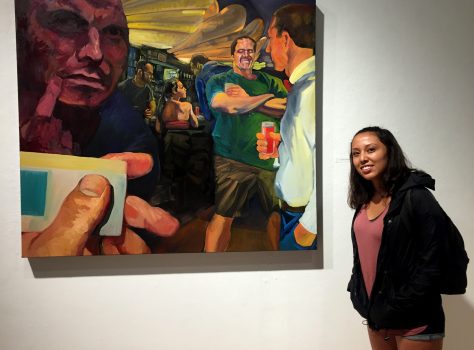Schedule
Last Warning: Organize your website
Many of you have “Site Title” as the name of your website. It should be something else! Like:
- Glenn Zucman Art110
- Art Adventures
- Glenn’s World
- Sailor Kelly
Also many of your themes came with “Demo Content” things like “Sample Post” that let you see how the theme will look even before you’ve posted much or any content. Now that you’ve got some content please delete those demo posts.
IF YOUR WEBSITE IS STILL NAMED “SITE TITLE” AFTER THIS WEEK I WILL NOT GIVE YOU POINTS FOR YOUR WORK.
If you need help with this or anything else, you can:
- Ask online
- Come to before class OH on Wed 11:30-12:30 @Robek’s / Coffee Bean umbrella tables
- I can go to AS-120 (AS building is next to The Beach Hut, next to The Library) after class on Wed, at 3:45 and help anyone with anything until all questions are answered.
- Make an appointment to meetup another time
Featured Images
When you’re making a post you can add images. I think you’ve all got this! 😀 You can also specify one image as your “Featured Image.” This image is the one that many themes will use on your home page. You’ll see on some of your websites that the demo posts show images on the home page and your new posts don’t. If you spedify a Featured Image that will fix this.
Artist Conversations
- Keep up the good work on Artist Conversations!
- Use the Syllabus / Sample Artist Conversation
Classmate Conversations
- Be sure to state your classmates First and last Names.
- Be sure to include a (live!) link to their website.
- We don’t have a Classmate Question OTW yet, why don’t you write one: glenn.zucman.com/i2va/fall16-qotw/
Post Naming!
Please use this format:
Wk2 – Art Experience – Plaster Casting
Wk2 – Artist Conversation – Brianna Allen
Wk2 – Classmate Conversation – Geri Weckstein
Most of you are using good post names, but a few aren’t. Remember that: Wk2 – Classmate Conversation – Geri Weckstein < the “Geri Weckstein” is the classmate / artist I talked to, not my own name! 😀
Points on BeachBored
All points through Week 3 are now up on BeachBored. Be sure to check your points and know where you stand! So far we’ve had 153 points possible. Here’s how many points you should have to be on track for each grade level, and how many peeps in 1p / 2:30 are currently at each grade level:
A = 138 points – 55 / 45
B = 122 points – 6 / 7
C = 107 points – 1 / 2
D = 92 points – 0 / 1
F = 91 points – 3 / 7
- 1p GPA = 3.69
- 2:30 GPA = 3.32
A lot of great work you guys – Congratulations! But we do have 11 peeps headed for D’s or F’s. If that’s you:
- Are you even reading this?
- You should get moving with the Art110 course work TODAY. Or drop the class TODAY. Do not just flounder not turning work in and digging a deeper and deeper hole for yourself!
If anyone has any questions or needs any help, please ask me. Sooner is better! My virtual OH is Monday 9-10am at glenn.zucman.com/i2va/chat. You can also ask questions there 24/7. You can also email me: glenn.zucman@csulb.edu. And my RL OH is Wednesday 11:30-12:30 at the Umbrella Tables outside Robek’s / Coffee Bean & Tea Leaf at the USU. I can also meet with you at other times by appointment.
Leaderboard
Top 5 @1pm:

- Maritess Anne Inieto, 205
- Stephanie Arciva, 196
- Melissa Rios, 194
- Carlos Villicana, 183
- Selena Lara, Joy Elizabeth Uba, Brian Sath, 178
Top 5 @2:30:

- Lydia Chang, 211
- Jamie Van, 198
- Adriana Maciel, 190
- Samantha Gomez, 183
- Jessica Obrique, 182


Activity Wk 4
Our Week 4 Art Activity is Automatic Drawing. Some of you will find it a lot of fun. Some of you will find it frustrating. Try not to get frustrated! Try to relax and have fun with it.
Your Art Kit came with 2 big sheets of paper and 3 pastel sticks. 1 sheet of paper is for this activity (the other sheet is for the “Finger Painting” activity.) Find a big board or heavy cardboard or something you can tape your paper down on. When I make these I usually just do 1 pass on them. But I’ve found that students like doing several passes on top of each other. That’s why you got the 3 colors of pastels.
Experiment. Have fun! Don’t stress.
- Full Details on the Automatic Drawing activity page
Art Talk OTW
- 3 Million Years of Art History
- Joseph DeLappe
- Mahsa Soroudi
- The Mind in the Cave
Nice discussion of Mahsa Soroudi’s work last week everyone! This week we’re finally back to the “AH Timeline” with The Mind in the Cave. We’ll look at some of the earliest human art, in this case from Lascaux, France, from about 16,000 years ago. We’ll also consider how this ancient art might connect to “futuristic” ideas as found in stories like the film The Matrix.


Comments? Questions? What great art did you see, make, or experience today?